Revista Electrónica de Investigación Educativa
Vol. 8, No. 1, 2006
Relationship between the Variables
Self-Concept and Creativity in a Sample
of Childhood-Education Students
Clemente Franco Justo
cfranco@ual.es
Departamento de Psicología Evolutiva y de la Educación
Universidad de Almería
La Cañada de San Urbano
04120, Almería, España
(Received: December 15, 2004;
accepted for publishing: November 16, 2005)
Abstract
In this work we attempt to prove through experimentation that a relationship exists between affective factors and creative ability. We therefore believe that the expression of the creative capacity will have a positive bearing on the manifestation of self-concept. To this end, we designed a psychoeducational program based on children’s stories, aimed at increasing creative ability in a sample of early childhood education students, while simultaneously obtaining improved expression of their self-concept. To do this, we used a quasi-experimental design of nonequivalent control groups with double pretest. As evaluation instruments we used the Torrance Tests of Creative Thinking (TTCT), and Villa and Azumendi’s PCSC test (Perception of Child Self Concept). The results of the study showed significant increases in the experimental group, both in their levels of verbal creativity (fluency, flexibility and originality), and in their self-concept, as compared with the control groups.
Key words: Creativity, self-concept, early childhood education.
Introduction
To Menchen (1999) the creative dimension is one of the most relevant vectors of preschool education, since it brings together all the other dimensions and expresses better than any other, the aspiration to train in an integrated manner.
De la Torre (1997) mentions that school experiences should contribute to the active incorporation of the child into the educational process; consequently there must be found a way to help her? develop and utilize her creative potential. He says that the teacher must accept the impulse toward creativity as something universal, since most researchers ultimately agree with Guilford (1983) that creativity is not the special gift of a chosen few, but is a property shared by all, to a greater or lesser degree.
Moreover, Borrajo (1998) affirms that the concept of education has taken on new meaning. It is no longer important to accumulate information. Instead, today’s model puts more value on knowing what information we need at each moment, where to get it, how to treat it, how to transform it, how to re-create it, and how to create on the basis of it. Therefore, from this author’s point of view, the adult must leave behind the role of information-transmitter and take up the role of creator of learning environments in which the child, with his abilities and limitations, is accepted—must provide him with a place for work and learning in which he can feel it safe to learn and develop his abilities without being afraid of being judged. He will find such environments stimulating, and will value both personal initiative, and the originality and responsible freedom every child exerts on his own learning process.
Harter (1993), posits the existence of a close relationship between the expression of this capacity and the security or confidence the person has in his own abilities. This relationship can be expressed, we believe, in two senses:
- People who have greater confidence in themselves can express themselves more easily than those who have less.
- People who are able to express their creative abilities to a higher degree tend to become more and more secure and confident.
Thus, one can appreciate the influence of affective factors in stimulating and expressing creativity.
Parallel to the child’s cognitive development is developing his affectivity. Regarding this, one of the most important aspects to consider is the development of self-concept, which is formed beginning from the time the child is very young, through the varied experiences he has with his environment. Adequate emotional development requires the development of a positive self-concept, since the concept the child has of himself will be decisive in his approach to the world and his relationships with people.
According to Burns (1998), the self-concept is an organized set of attitudes the individual has toward himself. The attitude has three components:
- The cognitive component (self-image): refers to the representation or mental perception the subject has of himself.
- The affective and evaluative component (self-esteem): refers to the evaluation the individual makes of himself.
- The behavioral component (motivation): refers to the importance of motivation in behavioral self-regulation processes or conduct.
According to López and Schnitzler (1983), in addition to having the three dimensions mentioned above, the concept of self is characterized as being:
- An organized system. It serves as a context for integrating new information about oneself, and for integrating and differentiating a vast number of things learned.
- Relatively stable. This means that there is a tendency to maintain, over time, the concept that one has of oneself, accepting what is consistent with this concept, and rejecting what differs from it.
- Dynamic. It is a process of continuous change, although directed by a central axis of stability.
- Multifaceted and hierarchical. It is postulated that there is a general self-concept, plus specific concepts associated with each role the subject plays (social, physical, academic, etc.) These concepts are organized around the general self-concept, which occupies the top position in the hierarchy.
Thus, the self-concept has to do with the image we have of ourselves, and refers to the set of characteristics or attributes we use to define ourselves as individuals and to differentiate ourselves from others. This knowledge is not present at birth, but is the result of an active process of construction, by the subject, throughout the whole time-span of her development.
In general, the authors who mention the issue agree that there is some relationship between these two variables. Concerning this, Guilford (1983) argues for the existence of such a relationship between self-concept and creativity, without determining which of these variables comes before the other. This means that having a positive self-concept contributes to the emergence of the human being’s creative potential. Furthermore, to the extent that the subject goes through experiences with the environment and gains creative achievements, her positive self-concept will be strengthened. In connection with the dilemma of which comes first, authors are divided in their opinions. Some say that a positive self-concept allows the emergence of creative potential, and others say it is the creative capacity that promotes the development of positive self-concept (Moore, Ugarte and Urrutia, 1987).
In the same measure as the person gets to know herself through the learning achieved via her interaction with the environment, she develops her self-concept. This development facilitates the demonstration of the individual’s potentialities, out of which emerges her creative potential (Zegers, 1981).
Broc (1994) has studied the effect of a positive self-concept in children’s lives. In his studies he has noticed that these children tend to be more creative; have a lower degree of anxiety; are more open, spontaneous, communicative and curious than children with a negative self-concept. By contrast, the latter perceive themselves as inferior and useless, feel depressed and belittle their potential. In general, these people do not trust themselves and are afraid to express their ideas.
As noted above, a positive self-concept can be promoted, although this process takes time and special conditions to achieve it. Thus, a psychological climate of acceptance and respect for individuality, where the subject feels he can have success, and where the people around him accept themselves the way they are, facilitates the development of a positive self-concept in individuals (Espriu, 1993).
Authors like Broc (1994) state that the self-concept is subject to change, whenever the dimensions that influence each developmental period are taken into account, and when they are worked on simultaneously and systematically. To this author, at the end of the early childhood education period (and still more at the beginning), in relating with the child it is essential to focus, not so much on aspects purely instrumental, but rather on aspects of the affect, adaptation, acceptance, life experience and security.
The main objective of this research was, therefore, to demonstrate the feasibility of encouraging and improving self-concept in a sample of very young students through a psychoeducational program aimed at stimulating the creativity of these children.
Out of the above objectives came the hypotheses guiding this research; these are presented below.
As a general hypothesis we hold that the stimulation of creativity can promote the development of a positive self-concept in children. The specific hypothesis is that those children submitted to program for stimulating creativity (experimental group) will show a significantly greater increase in their positive self-concept than those children not submitted to the program (control group).
1. Methodology
1.1 Subjects
The sample consisted of 71 children, 24 of them from the experimental group (11 boys and 13 girls), 25 belonging to the first control group (15 boys and 10 girls) and 22 to the second control group (10 boys and 12 girls). The children’s ages ranged from 5 years 0 months, to 5 years 11 months; all had a normal intellectual range of at least average.
The variable intellectual capacity was considered to control the possible involvement of this factor in the development of the children’s creativity, since authors like Rieben (1979) establish that the two aspects (creativity and intelligence) are interrelated, and claim that there is required at least a normal range of intellectual ability for developing fully the creative potential. Thus, to control the involvement of this variable, we established the criterion that the children in the sample should have a minimum intellectual range of average normal, IQ> 90, since this is the minimum IQ established by Repucci (1980) as necessary for the manifestation of creativity (Moore, Ugarte and Urrutia, 1987).
Accordingly, considered in the sample were all those children who met the above requirement, and who were between 5 years 0 months and 5 years 11 months of age. It is important to point out that in applying the program to the experimental group, we worked with all the children enrolled in the course, even though the sample and the data analysis took into account only those children who met the above conditions.
For reasons of experimental mortality, there were chosen natural groups of children who were in attendance the week the measuring pretest was applied.
1.2. Instruments
For the assessment of the children’s general intellectual ability, Raven’s Progressive Matrices Test was used (1966). This instrument is non-verbal, and assesses the general intellectual capacity of children between 5 and 12 years old by means of the visuospatial factor.
Because Raven’s test has a high saturation of the visuospatial factor, and to eliminate the influence of visuoperceptivo problems on performance on this test, we applied the Wechsler Preschool and Primary Scale of Intelligence (WPPSI) to those children whose scores on the Raven test fell below the 50th percentile, following the recommendations made by Moore, Ugarte and Urrutia (1987).
For the assessment of creativity, we used the verbal battery of the Torrance Tests of Creative Thinking (TTCT) (1974). This battery uses six word-based exercises to assess the subjects into three major mental characteristics related to creativity: fluidity (the subject’s ability to produce a large number of ideas with words); flexibility (ability to change from one approach to another, from one line of thought to another); and originality (ability to provide ideas or solutions which are not obvious, common or established).
The verbal battery of the Tests of Creative Thinking is suitable for group application beginning with the fourth grade of primary school. Up until that time (from infant level to third grade) its individual application is recommended.
Form A was used in the pretest phase and Form B form in the posttest, as suggested by the author, evaluating fluidity, flexibility and originality in accordance with the following criteria:
- Fluidity: a point is awarded for every idea presented, not taking into consideration those that are repeated and irrelevant (insofar as they do not meet the requirements of the specific task).
- Flexibility: There is evaluated the number of categories or thematic clusters of ideas possible, awarding one point for each category used. The different categories are explained in the manual for each of the activities.
- Originality: Scoring is based on the statistical rarity of the idea, according to the following criteria:
a) 0 points if the idea is expressed by more than three subjects.
b) 1 point if the idea is expressed by three individuals.
c) 2 points if the proposal or idea has been expressed by two subjects.
d) 3 points if the designated idea is expressed by one subject.
For the evaluation of the self-concept variable, we used the instrument Perception of Child Self Concept (PCSC) (Villa and Azumendi, 1992). This is a test for measuring self-concept in children aged 5-6 years. It consists of 34 items, each of which consists of a drawing with a group of boys and girls in a given situation (at school, at a birthday party, etc.) In the scenes one of the figures is performing an activity that could be described as representing a positive self-concept, and another, or others, are carrying out the same activity, but with a negative connotation.
In this study we used the individual form of this test, because, although it takes longer, according to the authors, it yields more reliable data on the child’s self-concept.
1.3. Procedure
To achieve the objectives of this study, we used a quasi-experimental design of group comparison, with pretest-posttest measurement, with an experimental group and two control groups. This measurement was done in order to explore the effects of the program (independent variable) on dependent variables such as verbal creativity and self-concept.
Since it was not an experimental design, we attempted to increase the internal validity of the study, for which we used a design with nonequivalent control groups.
Also applied was a triple-blind technique, since the children were unaware of the treatment, none of the teachers knew the purpose of the research (they were unaware of the existence of other research groups), and the evaluators did not know which group the subjects belonged to—experimental or control.
First we made an initial evaluation to find out the starting level, both for variable creativity, and for the self-concept of the children in the three groups. To do this there was applied individually, at school, the TTCT, Form A; and the PCSC, also individually.
In addition, Raven’s Progressive Matrices Test was individually applied at school, in order to obtain an estimate of the intellectual range of subjects participating in the study.
To control the possible effect the variable evaluator might have on the results obtained, four weeks before the first evaluation, the evaluators were incorporated into the same classes they would assess. They were presented as teacher-trainees, so that during this period they would have contact with the children, since according to Marín (1980), in the assessment of creativity an effective climate of trust and acceptance is necessary. Otherwise, students’ awareness of an evaluatory environment would inhibit the expression of creative responses.
Next came the implementation of the program in the experimental group. The program’s purpose was to adapt the 35 activities of Andreucci and Mayo’s program (1993), based on five selected traditional stories (Little Red Riding Hood, Hansel and Gretel, Cinderella, Bambi and Pinocchio), so as to improve creative ability in preschoolers.
Seven activities were planned for each story (35 in total), one being used at each session, after reading the story in question (two sessions per week). These activities took into account both affective and cognitive aspects, two additional factors for the development of creativity. Especially encouraged were three areas of this potential: flexibility, fluidity and originality, not forgetting other factors necessary for an adequate stimulation of creativity, such as maintaining a climate of trust, freedom and humor. The activities also incorporated various types of expression: verbal, visual, dramatic, etc.
The objectives of the activities were to promote the three dimensions of creativity mentioned above, mainly through three basic criteria for developing divergent thinking (Andreucci and Mayo, 1993):
1. Unusual applications.
2. Improvement of the object.
3. Let’s imagine.
After the implementation of the program designed, a posttest evaluation was conducted with the three groups, using TTCT Form B, and the individual PCSC test. The objective of this evaluation was to verify the effect of program application on the stimulation of creativity by using the story and the activities derived from it, and their effect on children’s self-concept.
2. Results
To analyze the results of the evaluation of creativity as well as those of self-concept, a comparison was made by means of a covariance (ANCOVA) analysis, which evaluated the change produced by the program. For this analysis we used the SPSS statistics program, version 11.0.
We conducted an ANCOVA for each variable in the posttest, using as covariate its equivalent in the pretest, which would indicate the levels of the variable previous to applying the treatment to the experimental group. In this way we were attempting to eliminate the influence which previous levels of creativity and self-concept might have had on the posttest results.
We used an analysis of covariance as a technique for analyzing the data obtained, since it is a technique recommended for times when one has a small number of subjects or when natural groups have been used (García Jiménez, 1992). Moreover, according to García, Frías and Pascual (1999), it is the best data-analysis technique known for designs with nonequivalent control groups.
We also conducted an analysis of variance (ANOVA) of each variable on the posttest, which would analyze the existence or nonexistence of significant differences between the groups, regardless of their beginning levels of creativity and self-concept. We always had to interpret the results of this analysis in the light of those obtained in the ANCOVA, since important differences could be obtained. These could be blamed on the experiment, when they might be due simply to the variety of creativity and self-concept levels with which the subjects of the study started out. Conversely, the effects of the experiment could be camouflaged if the gains made by the different groups ended up matching the final results because the subjects began from different levels of creativity and self-concept.
Also, a multiple-range or multiple-comparison test was done, with the aim of finding out which groups had differences between them. This test would not have fit into in this study if we had worked with only two groups, but in our case it was necessary to confirm that the differences we found was between each of the control groups and the experimental group, and not between the two control groups themselves (see Table I).
Table I. Average points for the variables flexibility, fluidity, originality and self-concept of the three groups in the two measurement stages
Variable Group Measurement Averages
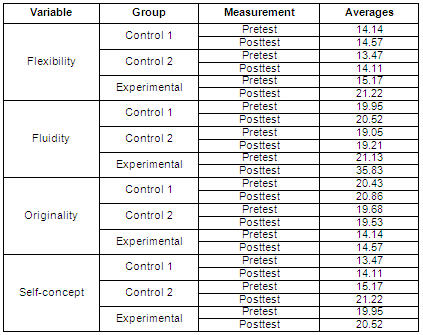
The statistical analysis of data yielded the following results:
1) We obtained significant differences between the control groups and the experimental group (F = 31.419, p<0.001), in the variable verbal flexibility (see Figure 1).
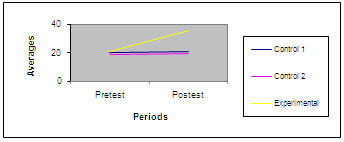
Figure 1. Evolution of the variable fluidity in groups
Control 1, Control 2, and Experimental
2) There were also significant differences between groups in the posttest (F = 7.4, p = 0,001) for the variable verbal fluency (see Figure 2).
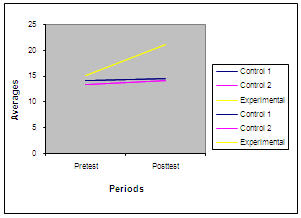
Figure 2. Evolution of the variable flexibility in the groups
Control 1, Control 2 and Experimental
3) Regarding the variable verbal originality, significant differences were also found between groups in the posttest in favor of the experimental group (F = 7.194, p = 0.002) (see Figure 3).
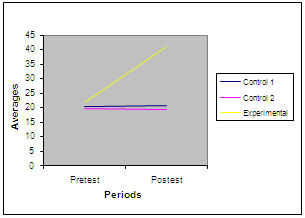
Figure 3. Evolution of the variable originality in groups
Control 1, Control 2, and Experimental
4) Finally, in relation to the assessment of self-concept, there were also significant differences between the control groups and the experimental group in the posttest measurement (F = 6.994, p = 0.018), good values: F = 12.017, p <0.001 (see Figure 4).
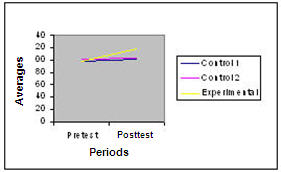
Figure 4. Evolution of the variable self-concept in the groups
Control 1, Control 2, and Experimental
3. Discussion
The creativity program we applied produced a significant increase in the expression of the children’s creative potential, in the dimensions of fluency, flexibility and originality. This improvement also produced a significant increment in the self-concept of children subjected to this intervention program.
In sum, as related to the system of hypotheses, the following can be concluded:
The results of this investigation fully confirm the main hypothesis that underlies it. That is, the self-concept can be stimulated through the implementation of a psychoeducational program based on stories, and designed especially for the development of creativity. Thus, there was confirmed the specific hypothesis referring to the program’s impact on the subjects’ creativity and self-concept, since it was found that those who underwent the application of the program (the experimental group) showed a significantly-greater increase in their expression of creative ability and their self-concept than those who were not submitted to the implementation of the program (the control groups).
These results demonstrate the importance of developing and stimulating creative potential as early as possible in the child’s development, and at the infant level, where even little children can express themselves freely, since, as has been proven in the research presented here, the creative achievements of an individual constitute the basis for positive self-concept.
The early childhood stage is decisive in the development of the individual. According to Espriu (1993), at this stage the child’s readiness for formal learning is crucial. Bean (1994) also expresses this, when he points out that the scientific evidence from various disciplines has identified the preschool years as critical for implanting actions that will have a decisive influence on the person’s later development.
Extending this stimulation to the other levels will facilitate a full and stable development of the creative capacities of the individual, of and a positive self-concept, both of which constitute, and are fundamental in the overall growth process.
Therefore, a creative teaching style which considers both modalities, should be integrated into and applied throughout the whole educational system, and should include a methodology and specific strategies for developing creativity. The activities to be performed should be suited to the characteristics of the children and their stage of development, in terms of variety, quantity, duration, significance and level of abstraction, thus ensuring, insofar as possible, the motivation necessary and inherent in any learning process (Andreucci and Mayo, 1993).
Furthermore, this would allow children to learn in a less-conventional way, and would encourage them to look beyond the established, to investigate and discover new alternatives for solving problems, to use their imaginations more, to be more open toward unfamiliar experiences and a large dose of authenticity and individual security.
Creativity is an inherent capacity, and is indissociable from child development. However, educational experiences can limit or inhibit the manifestation of that capacity. Thus, children with a positive self-concept can dominate and overcome the contradictions; will be more confident in their abilities; and will tend not to suppress their emotions and feelings. They will feel more free and motivated to create and channel their creative impulses in a more constructive and enriching way, both for themselves and for the people around them.
Promoting creativity and self-concept in the very young, will have the effect of increasing their quality of life as children, since they will be more socially well-adjusted in their play, will have higher expectations for themselves and their future, will demonstrate friendly contacts with people in their immediate environment, will be active and flexible and will be able to communicate their thoughts and concerns openly and without fear.
They will also be aware of their identity and personal usefulness. They will feel socially competent, will be able to make decisions and set realistic goals, while they will be able to satisfy their basic needs for affection, because of the opportunities the school environment provides for the development of personal skills. All this, thanks to the educational system’s recognition and attention of their successes and skills. Hence the need to stress the importance of putting the emphasis not on what children are unable to perform and will fail at, but rather on providing learning situations and opportunities where they can test their skills and abilities.
The child must feel his teacher’s full support during the learning process. Such support should not be subordinated to the child’s achievements or failures. He requires, from his teacher, an affection conditioned not by his school achievement, but by the recognition of his being unique and individual. Thus, the psychological climate that predominates in the classroom should be, insofar as possible, relaxed and happy, free from fear and value judgments regarding the learners’ work and behavior; an atmosphere of calm and confidence, which rewards initiative and innovation, and that is both attractive and stimulating. In this way, the flame of creation will be kept alive, and the child’s natural instinct to create will be displayed fully in all its aspects.
It is for this reason that the development of creativity and self-concept are closely related to the existence of an affective environment and a teacher-student relationship, which will facilitate the free expression of the child.
It is essential to establish within the classroom, a good teacher-student interaction, a relationship based primarily on acceptance, warmth, empathy and congruence in a flexible and participatory teaching method, to promote the achievement of significant experiential learning for children. Children should be able to interact actively with their teachers, and the teachers must harness and embrace their students’ feelings and concerns, and allow them to express themselves freely. The teacher should be, therefore, a security figure for the child, someone who will encourage and incite him to express his capacity for creation, and who will encourage and strengthen each new attempt to achieve something different and unique. When all is said and done, something of his own, something of which he can feel terribly proud. Proud of his creative self.
References
Andreucci, C. & Mayo, B. (1993). El cuento como vehículo para desarrollar la creatividad en preescolares. Unpublished doctoral dissertation. Universidad Católica de Chile.
Bean, R. (1994). Cómo desarrollar la creatividad en los niños. Barcelona: Círculo de Lectores.
Borrajo, G. (1998). Expresión creativa desde la cuna. Santiago de Compostela, Spain: Universidad de Santiago de Compostela.
Broc, M. A. (1994). Rendimiento académico y autoconcepto en niños de educación infantil y primaria. Revista de Educación, 303, 281-297.
Burns, R. B. (1998). El autoconcepto. Teoría, medición, desarrollo y comportamiento. Bilbao: EGA.
De la Torre, S. (1997). Creatividad y formación. Mexico: Trillas.
Espriu, R. M. (1993). El niño y la creatividad. Mexico: Trillas.
García Jiménez, M. V. (1992). El método experimental en la investigación psicológica. Barcelona: PPU.
García, J. F., Frías, M. D., & Pascual, J. (1999). Los diseños de la investigación experimental. Comprobación de las hipótesis. Valencia: CSV.
Guilford, J. P. (1983). Creatividad y educación. Barcelona: Paidós.
Harter, S. (1993). Visions of self: beyond the me in the mirror. Lincoln, NE: University of Nebraska Press.
López, E. & Schnitzler, E. (1983). Factores emocionales y rendimiento escolar. Buenos Aires: Paidós.
Marín, R. (1980). La creatividad. Barcelona: CEAC.
Menchen, F. (1999). Dimensión creativa. In M. Carretero, Pedagogía de la escuela infantil (pp. 269-285). Madrid: Santillana.
Moore, C., Ugarte, M., & Urrutia, E. (1987). Estimulando la creatividad: una experiencia en el sistema educacional chileno. Unpublished doctoral dissertation. Universidad de Chile.
Raven, J. C. (1966). Test de matices progresivas. Barcelona: Paidós.
Repucci, L. (1980). Investigaciones sobre la creatividad. In G. A. Davis & J. A. Scott (Eds.), Estrategias para la creatividad (pp. 30-42). Buenos Aires: Paidós.
Rieben, L. (1979). Inteligencia global, inteligencia operatoria y creatividad. Barcelona: Médica y Técnica.
Torrance, E. P. (1974). Torrance test of creativity thinking. Norms technical manual. Verbal tests, forms A and B; figural tests, forms A and B. Princeton, NJ: Personnel Press.
Zegers, B. (1981). Proposición de un modelo analítico de la psicología de sí mismo. Revista de Estudios Sociales, 15, 32-43.
Translator: Lessie Evona York-Weatherman
UABC Mexicali
Please cite the source as:
Franco, C. (2006). Relationship between the variables self-concept and creativity in a simple of childhood-education students. Revista Electrónica de Investigación Educativa, 8 (1). Retrieved month day, year, from: http://redie.ens.uabc.mx/vol8no1/contents-franco.html




